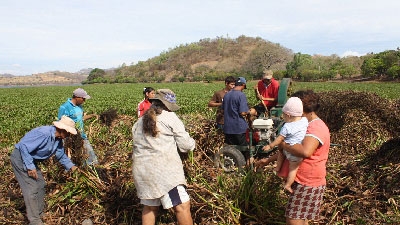El Salvador, the smallest country in Central America, has experienced modest economic growth in recent decades, with an annual rate of 2.5 percent between 2013 and 2019. Still, the country managed to significantly reduce poverty and inequality. In 2019, the Gini Index, which ranges from 0 to 1, with 0 representing perfect equality and 1 representing perfect inequality, fell below 0.4, a value considered by the World Bank to be an indicator of high inequality.
The COVID-19 pandemic had a significant negative impact on people’s lives and families’ incomes. Although El Salvador was quick to adopt strong containment measures against the outbreak and the government rolled out a robust fiscal response to limit the pandemic’s impact on households and businesses, the pandemic dealt a major blow to growth as gross domestic product (GDP) declined by -7.9 percent in 2020.
In 2021, El Salvador’s economy grew by 11.2 percent, while growth moderated to 2.6 percent in 2022 and 2.7 percent in 2023, and is expected to hold steady at an average of 2.7 percent in 2024. In the medium term, GDP is forecast to converge to 2.5 percent, above historical averages, on the back of private consumption, public investment, and tourism.
Upper-middle-income and lower-middle-income poverty lines, measured at US$6.85 and US$3.65 per person (2017 purchasing power parity - PPP), were 27.5 percent and 8.6 percent in 2022, respectively.
National poverty rates tell a mixed story. The moderate poverty rate remains relatively stable, slightly below the prepandemic level (despite an increase between 2019 and 2020), while the extreme poverty rate increased in 2022, remaining 4.1 percentage points above the 2019 rate.
Challenges persist in El Salvador, such as the need to advance reforms for fiscal sustainability. The fiscal response to the COVID-19 crisis helped mitigate its impacts, cost around 16.5 percent of GDP and, together with low revenues and rigid expenditures, pushed public debt to beyond 90 percent of GDP.
Although debt has declined in recent years, it is still above prepandemic levels and the country’s fiscal position remains fragile. The government faces liquidity pressures and has few financing alternatives. A well-defined medium-term fiscal framework could reduce uncertainty and allow the country to regain the ability to issue debt in international markets to foster sustainable growth.
Despite challenges, El Salvador has tremendous potential to drive a dynamic, inclusive, and resilient economic growth. The country can continue to prioritize ramping up investments in human capital to foster accumulation and enhance the effectiveness of the social protection system. It can also boost public and private investment, promote access to high-quality jobs, and foster a more dynamic, competitive, and innovative private sector.
To reduce vulnerabilities, El Salvador can also promote a sustainable and equitable fiscal policy, build resilience to disaster risk and pandemics, and strengthen governance and institutions.
Last Updated: Apr 03, 2024



